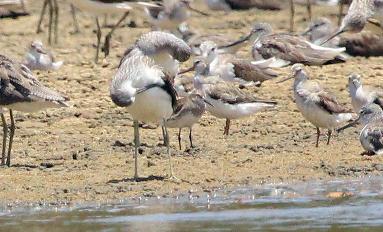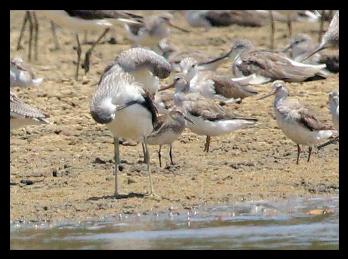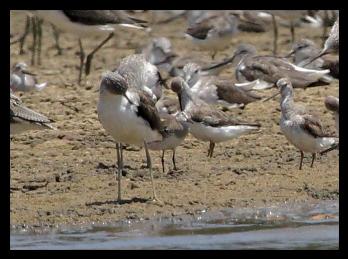(277) White-rumped Sandpiper - Calidris fuscicollis
Source
"I have no doubt that the bird in question is, as proposed by the OP, a White-rumped Sandpiper in non-breeding plumage, albeit with its rear end (the length of which normally provides one of the best ID clues) hidden behind the preening Greenshank. As has already been mentioned by others, the relative size (not as small as a stint) solid grey breast with continuation of grey marking along flank, medium/short bill (much too short for Curlew Sandpiper) and its overall jizz match White-rumped perfectly. A Baird's in winter would have a slightly different head-pattern, a straighter bill and much more sandy-buff colouration.
I have taken the liberty of grabbing a still off a video-clip of White-rumped Sandpipers filmed in Argentina in December 2012 by Martin Manassero (available on the Lynx website) and placing it alongside the bird in question.
I'm not sure of the status of White-rumped Sandpiper in South Africa but I guess it is not extremely rare, so the presence of this bird should not be so surprising. It may even have been recorded by others or, if it was photographed just last month it could still be present?
Killian Mullarney
Killian Mullarney is an Irish ornithologist, bird artist[1] and bird tour leader.[2] He designed a series of Irish definitive stamps for An Post illustrating Irish birds[3] issued between 1997 and 2004.
He was born in Dublin in 1958,[4] and educated at home for a few years by his mother, Máire Mullarney. He showed an interest in birds from an early age, including bird art, and began to make a name for himself in the late 1970s. Due to his keen interest in bird identification, he served as a member of the Irish Rare Birds Committee[2] from 1980 to 2008, and serves as an identification consultant to many birding journals, including Birding World and Alula. He also wrote an influential series of articles with Peter J. Grant for Birding World which were later produced independently as 'The 'New Approach to Identification'.[2]
He was jointly responsible, with Dan Zetterström for illustrating the Collins Bird Guide, which was written by Lars Svensson and Peter J. Grant[2] and has been described by Birding World as "undoubtedly the finest field guide that has ever been produced", and "the last great bird book of the 20th century""

Durban Bayhead
Canon Canon EOS 60D (5.6 , 5.0 , 1/6400 seconds , 2014:12:21 12:20:50)

Durban Bayhead
Canon Canon EOS 60D (5.6 , 5.0 , 1/6400 seconds , 2014:12:21 12:20:50)

Durban Bayhead
Canon Canon EOS 60D (5.6 , 5.0 , 1/6400 seconds , 2014:12:21 12:20:51)

Durban Bayhead
Canon Canon EOS 60D (5.6 , 5.0 , 1/5000 seconds , 2014:12:21 12:21:30)
Seasonal occurence
 Resident
Resident Breeding
Breeding Non-breeding
Non-breeding Passage
Passage Uncertain
UncertainSend me mail at info@laine-dirk.co.za.